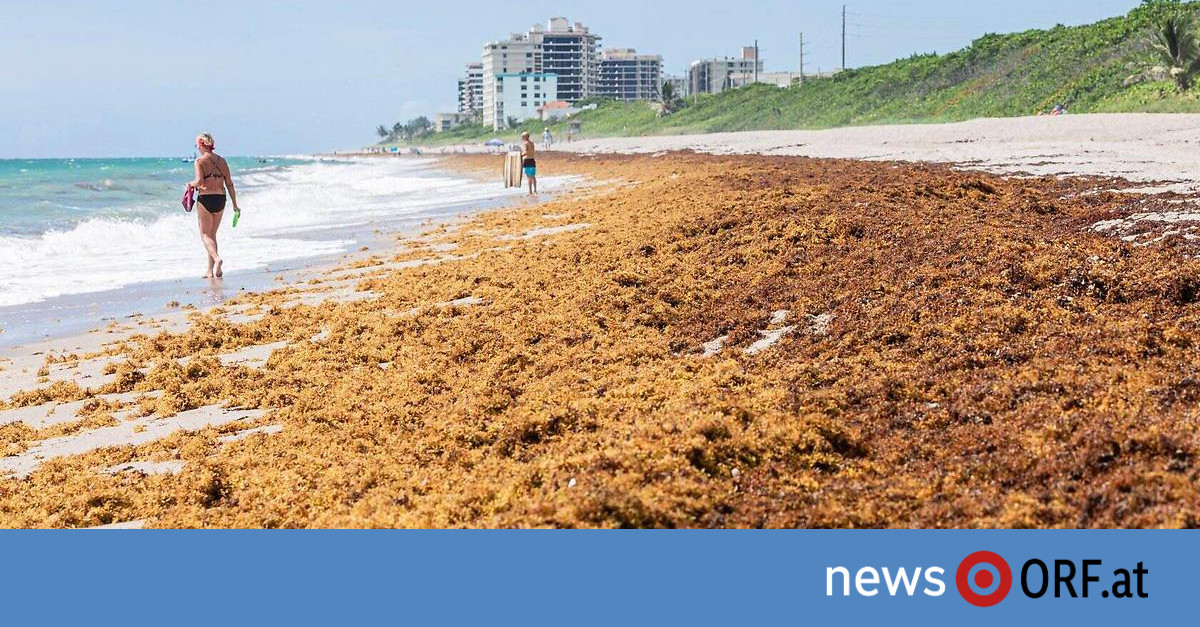For most of the year, the carpet of algae swims harmlessly across the Atlantic and poses no threat. It offers shelter for fish, crabs and sea turtles. It extends over around 8,000 kilometers and is almost twice as wide as the entire USA. Because of its gigantic size, it can even be seen from space.
In the summer months, however, the huge mass could reach the shores of Florida and other areas in the Gulf of Mexico, as the “New York Times” (“NYT”) reported. The species of algae called sargassum could then begin to rot, releasing toxic fumes and polluting beaches.
Increasing amounts
Piles of seaweed have already begun to cling to the shores of Key West, Florida. In Mexico, too, seaweed was found on the beaches south of Cancun in the last month. “You can’t go in the water,” travel YouTuber Leonard Shea said in a video referenced by The New York Times. It features boats in muddy waters and brown-tinged waves crashing onto seaweed-covered beaches.
“The algal blooms are getting bigger and it looks like this year will be the biggest yet,” Florida Atlantic University research professor Brian Lapointe told NYT. In January, the largest growth in this month since records began was measured. “It’s still early to see so much,” Lapointe said. The researcher said that this would not bode well for a clean beach summer in 2023.
seasonal phenomenon
Sargassum – a type of macroalgae that occurs naturally in the eponymous Sargasso Sea – has long been seen in larger clusters in the North Atlantic. In 2011, however, scientists began observing increasing amounts of the seaweed stretching in a vast carpet from West Africa to the Gulf of Mexico, according to a 2019 study.
Over the years, these vast masses of sargassum have continued to expand. Scientists suspect a seasonal phenomenon behind this, which has to do with the runoff of large rivers such as the Congo, Amazon and Mississippi. These would help supply the algae with nitrogen and phosphorus, Lapointe explained. Fossil fuel emissions and biomass burning would also provide nutrients that encourage Sargassum growth, the researcher said.
Danger for humans and fauna
The sargassum can also suffocate important mangrove habitats and deprive the water of oxygen. In addition, the rotting algae would release hydrogen sulfide. A colorless gas that smells like rotten eggs and can cause respiratory problems in humans. In 2018, thousands of cases of acute exposure to hydrogen sulfide were reported on the Caribbean islands of Guadeloupe and Martinique.
Last summer, the US Virgin Islands declared a state of emergency after “unusually large amounts” of sargassum accumulated on its shores and affected a desalination plant on the island of St. Croix. In the past, besieged beach towns have resorted to drastic measures to stop the sargassum: In Mexico, for example, the navy has been hired to scoop the seaweed out of the sea and rid the beaches of it.

Some entrepreneurs have considered converting the algae into animal feed, fuel or building materials. However, researcher Lapointe warns against experiments and new uses with the seaweed: sargassum contains arsenic, which if used as a fertilizer could potentially find its way up the food chain. According to Lapointe, however, the greatest threat is to tourism. “It’s going to be catastrophic,” he said.
According to the National Oceanography and Atmospheric Administration, the sargassum bloom will continue to affect the region around the Gulf of Mexico until mid-October.
